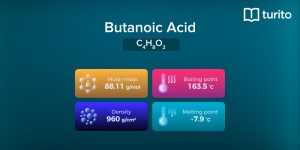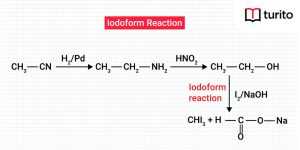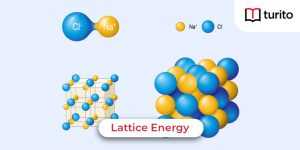Tryptophan
The codon UGG is used to transcribe tryptophan, an α-amino acid utilized to produce proteins. The symbol for it is Trp or W. It has the chemical formula C₁₁H₁₂N₂O₂. The chemical structure of tryptophan is a nonpolar aromatic amino acid with an α-amino group, an α-carboxylic acid group, and an indole side chain. It cannot be manufactured by the body and must be absorbed from human food since it is an essential nutrient. Tryptophan is a precursor to vitamin B3, hormonal melatonin, and serotonin neurotransmitter. Serotonin is a mood stabilizer, melatonin helps regulate the sleep cycle, and Vitamin B3 plays a vital role in keeping the skin and nervous system healthy.
Physical Properties of Tryptophan
- It is a solid color, slightly yellowish-white, with no odor and a bland taste.
- The chemical formula of tryptophan is C₁₁H₁₂N₂O₂. The molecular formula and the chemical formula for tryptophan will be the same.
- The chemical structure of tryptophan has an indole substituent at the position of the β carbon. Based on its chemical structure, tryptophan is the largest of all the amino acids.
- Tryptophan has a molar mass of 204.229 g·mol−1.
- Tryptophan is not soluble in formaldehyde and ethyl ether but dissolves readily in heated ethanol, alkali hydroxides, and acetic acid.
- Trp’s melting point is 290.5 °C.
Production of Tryptophan
Tryptophan must be available in the diet in the form of proteins that include the amino acid since it cannot be produced by humans or other animals from simpler molecules. Plants and bacteria often produce tryptophan from shikimic acid or anthranilate. The production of tryptophan can be catalyzed by tryptophanase in the condensation reaction between indole and L-serine to create the amino acid. Due to indole’s extremely poor solubility in water, this method has a significant disadvantage. Two liquid phases, an organic solvent containing indole and an aqueous phase, can be used to remedy the issue. The steps involved in the production of tryptophan are as follows:
- Anthranilate and phosphoribosylpyrophosphate (PRPP) condense, producing pyrophosphate as a byproduct.
- Indole-3-glycerol phosphate is created when the ring of the ribose component is broken and exposed to reductive decarboxylation. Indole is then produced from this compound.
- In the last phase, tryptophan synthase catalyzes the conversion of indole and the amino acid serine into tryptophan.
Functions of Tryptophan
Tryptophan is a necessary amino acid that must be consumed in the diet. Natural tryptophan helps the body make serotonin, which has several positive effects on health, including promoting sound sleep, easing anxiety and depression, enhancing mental well-being, and regulating pain threshold. Some of the other important functions of tryptophan are:
- Tryptophan and tyrosine residues in cell membrane proteins, as well as other components, all perform special functions in the “anchoring” of the membrane.
- Along with other aromatic amino acids, tryptophan is crucial in the relationships between glycans and proteins.
- Some chemicals utilize tryptophan as a biological precursor. Tryptophan is a building block for serotonin and melatonin in the body. Serotonin is known to assist in controlling emotions, pain, rest, and hunger, and melatonin aids in regulating the sleep-wake cycle.
- Niacin, a vitamin B3 required for DNA synthesis and energy metabolism, may also be produced by the liver using tryptophan. The body needs the following things for tryptophan in the diet to convert to niacin:
- Iron
- Riboflavin
- B6 vitamin
- The natural calming properties of tryptophan may promote restful sleep and enhance general health. According to research, an important function of tryptophan is to help make other important amino acids more accessible by converting them to the soothing neurotransmitter serotonin in the brain. In turn, this can aid in mood regulation and reduce the release of stress hormones.
- Although tryptophan is frequently used to treat insomnia and other sleep problems, additional study is required to establish its safety in treating these illnesses.
Tryptophan as a Drug
Low tryptophan levels bring on depression and anxiety. It has been proposed that tryptophan or 5-HTP ingestion might lessen the symptoms of depression by raising the amount of serotonin in the brain because tryptophan is transformed into 5-hydroxytryptophan (5-HTP), which is then turned into serotonin as a neurotransmitter.
For people who don’t appear to respond effectively to traditional antidepressants, tryptophan is sold as a prescription medication (Tryptan). Additionally, persons suffering from the seasonal affective disorder may benefit from its usage (a winter-onset depression).
Side Effects of Tryptophan as a Drug
The hazardous and fatal illness known as eosinophilia-myalgia syndrome has been connected to L-tryptophan (EMS). EMS results in skin changes, nerve damage, abrupt and acute muscular pain, and other incapacitating symptoms.
Tryptophan side effects might include:
- Distorted vision
- Dizziness
- Sleepiness and exhaustion
- Urticaria
- Nausea
- Muscular stiffness and a decline in muscle coordination
- A strong heartbeat that is hammering (palpitations)
- Perspiration
L-tryptophan can conflict with a wide range of medications. If you are on atypical antidepressants or selective serotonin reuptake inhibitors (SSRIs), avoid taking L-tryptophan. Serotonin syndrome, a potentially fatal illness, might result from doing so. Serotonin syndrome signs include:
- Massive anxiety
- Quick to startle
- Palpitations
- Painful muscle spasms
- High body temperature (pyrexia)
Pregnant women should consume L-tryptophan supplements with care. Any supplements you take, even natural ones and those obtained without a prescription, should always be disclosed to your doctor. Your doctor can then look into any possible adverse effects or drug interactions.
Sources of Tryptophan
Tryptophan may be found in the majority of dietary or food-based proteins. Particularly plentiful foods include chocolate, oats, milk, dried dates, sunflower seeds, yogurt, buckwheat, cottage cheese, pork, red meat, poultry, eggs, sesame, chickpeas, almonds, pumpkin, and spirulina.
Foods that contain tryptophan include:
1. Milk
One of the best sources of tryptophan is whole milk, which has 732 milligrams per quart. 2 percent reduced fat milk, which has 551 milligrams per quart, is another excellent source.
2. Tuna in cans
Another excellent source of tryptophan, at 472 milligrams per ounce, is canned tuna.
3. Chicken and turkey
Despite what many people think, turkey is not the main source of tryptophan but is a significant source. Dark meat has 303 milligrams per pound, whereas light meat has 410 milligrams per pound (raw). Tryptophan is found in significant concentrations in chicken; light meat has 238 milligrams per pound, and dark meat has 256 milligrams per pound.
4. Oats
With 147 mg of tryptophan per cup, cooked oatmeal can also be a rich supply of this amino acid.
5. Cheese
Cheddar cheese has 91 milligrams of tryptophan per oz, which is still lower than meat and other dairy products in terms of tryptophan content.
6. Nutty foods and seeds
In this category, peanuts are an example, with 65 milligrams per oz.
7. Bread
Whole wheat bread can have as much as 19 mg in a piece, whereas refined white bread can have as much as 22 mg.
8. Chocolate
Tryptophan levels in one ounce of chocolate can reach 18 milligrams.
9. Fruits
Some fruits can also be a good source of tryptophan. For example, a medium-sized banana contains approximately 11 milligrams of it. Additionally, a medium-sized apple contains around 2 milligrams of tryptophan, while a single prune contains 2 milligrams of this amino acid.
Conclusion
Tryptophan, the most prominent amino acid, is also an alanine analog with an indole group on the carbon. In the near UV spectrum region, the indole functional group absorbs substantially. Because indole nitrogen may give hydrogen bonds, tryptophan, or at least the nitrogen, is frequently in touch with fluid in coiled proteins.
The formation and maintenance of the body’s proteins, muscles, enzymes, and neurotransmitters depend on the amino acid tryptophan, which is also necessary for newborns’ optimal development. This amino acid is essential. As a result, you must obtain it from your food since your body cannot create it. Tryptophan contributes to synthesizing the mood-stabilizing chemicals serotonin, melatonin, niacin or vitamin B-3, and nicotinamide, commonly known as vitamin B-3. In 1989, the United States outlawed selling supplements containing synthetic tryptophan over-the-counter. However, tryptophan supplements were once again made accessible in 2001.
Frequently Asked Questions about Tryptophan
Q1. What distinguishes tryptophan from other amino acids?
Answer: Tryptophan (Trp) has a unique role in biology for various reasons. It is the most abundant of the twenty amino acids found in the molecular toolkit. It has an aromatic side chain with a binucleated ring, while Phenylalanine, Tyrosine, and Histidine have single-ring aromatics.
Q2. Can I take tryptophan daily?
Answer: Since tryptophan is an amino acid in many foods, it is considered safe in moderate amounts. An average diet comprises 1 gram of tryptophan per day, although some people opt to supplement with quantities of up to 5 grams per day. Overdose of tryptophan from supplements can induce shaking, shivering, hyperactive reflexes, disorientation, fever, vomiting, diarrhea, uneasiness, and anxiety. If you suffer any of these symptoms, get medical attention immediately.
Q3. What is tryptophan, and why is it important?
Answer: Tryptophan is an essential amino acid that plays various vital roles, including adult nitrogen balance and newborn development. It also generates niacin, which is required to form the serotonin neurotransmitter.

Relevant Articles
Butanoic Acid – Structure, Properties, Uses
Butanoic Acid The carboxylic acid, butanoic acid, has the structural …
Butanoic Acid – Structure, Properties, Uses Read More »
Read More >>What is Iodoform? Characteristics and Uses
Iodoform The formula for Iodoform is CHI3. It is biotic …
What is Iodoform? Characteristics and Uses Read More »
Read More >>Lattice Energy – Explanation, Factors & Formulas
Lattice Energy Lattice energy evaluates the intensity of the ionic …
Lattice Energy – Explanation, Factors & Formulas Read More »
Read More >>Lead Acetate – Definition, Properties, Uses
Lead Acetate Have you ever licked lipstick when you sketch …
Lead Acetate – Definition, Properties, Uses Read More »
Read More >>





















Comments: